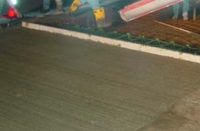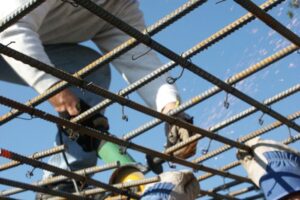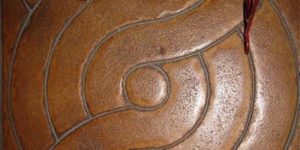What do you think of when you hear the term “sealer maintenance”? If you are like most in the industry, the first thing that comes to mind is waxing or buffing a previously sealed interior floor. Well, with spring upon us, it’s a great time to talk about another kind of sealer maintenance – maintaining exterior stamped or textured concrete.
Maintenance of exterior concrete is as important as maintaining interior concrete when it comes to aesthetics and protection. Most can agree that without the right sealer, stamped concrete can look drab and washed out. The sealer is what brings out the color and adds the finishing touch. It also serves as the critical protective barrier to common everyday dirt and contamination. So why then is so little attention paid to maintaining sealers on exterior stamped work as compared to interior sealing?
Before we can maintain sealed stamped concrete, we need to understand what we are maintaining. By far the most common sealer used on exterior stamped concrete is a solvent-based acrylic product. These can be cure-and-seals or straight sealers, with typical solids ranging from 15 percent to 30 percent. Acrylics fall into the thin-build category of sealers, with cured dry-film thicknesses ranging from less than 1 mil to 2 mils – very thin. These types of acrylic sealers provide the best cost-to-performance ratio for the task at hand. Another reason we see solvent-based acrylics used so often is because of their recoat ability. They exhibit great intercoat adhesion when applied on top of each other, a factor that comes into play when resealing.
The industry standard for maintenance of exterior stamped concrete seems to be some variation of the following: Reseal every one to three years, depending on environment and type of traffic, using the same sealer as was originally applied. Reseal in the spring when the threat of cold weather has passed.
While this is pretty general, with room for interpretation, it pretty much covers all the key points. What it fails to mention is that maintenance should be going on in those one to three years. Stamped concrete is an investment that often costs two to five times what its plain gray counterpart costs. If an end user wants to keep their investment looking its best, they have to take ownership of and responsibility for that investment. This is where the disconnect often takes place.
Pay $15,000 for a new car and you know that regular maintenance (oil, tires, fluids, etc.) is part of the deal for the life of the car. Now have someone pay that same $15,000 for a new stamped concrete patio. They see concrete with no maintenance. It’s colored, resembles stone or tile, and costs more to install, but in the end it’s concrete. Unfortunately this is bred into our society, as all concrete is lumped together in a category of materials that last forever, serve a purpose and require no maintenance. This is why it is so important that the installer sell stamped concrete as the high-end investment it is. That includes presenting detailed maintenance guidelines before the contract is signed and work begins.
A few of the key maintenance guidelines for stamped concrete that I promote:
Keep it clean. Sand, dirt and grit are what really eat up sealers on exterior stamped concrete. The small razor-sharp edges act like sandpaper every time someone walks across the surface or the wind blows. Regular sweeping or light soap-and-water washes can make a huge difference in extending the life span of the sealer.
Easy on the salt. While salt itself is not the culprit, what it does to water is. Salt reduces the freezing temperature of water, increasing the number of freeze-thaw cycles. This increased number of water expansions and contractions affects the concrete. You want to minimize the amount of standing water on the concrete during the cold freeze-thaw months to minimize the potential for damage.
Encourage shoveling instead of salting, and if salt must be used, sweep off the excess salt and melt water once the snow has melted. I even encourage owners who use salt to hose down their stamped concrete on those occasional warm days in the winter. Absolutely NO SALT on concrete less than 12 months old!
Think thin on the reseal. When the time comes to actually reseal, go thin. The sealer should go further than the stated coverage rate on any reseal. Remember, you are not applying a base coat – you’re reinforcing what is already down on the surface. Don’t reseal every year as a matter of rule, but rather as needed when the old sealer has worn down.
Strip the old to make room for the new. In time, all good things come to an end. This holds true for properly applied sealer on stamped concrete. After many years and multiple reseals, dirt and contamination will naturally get ground into the sealer to the extent that regular cleaning will no longer get it out. At this point the stamped concrete will not look good, even after resealing. This signals the time when stripping off the old layers of sealer must be done so you can start over from a clean concrete substrate. Stripping sealers from stamped concrete sucks, and that is an understatement, but over a long time and many reseals it may become necessary.
Call the installer. Consider maintenance as a new revenue stream. Instead of installing the stamped concrete and hoping the client loses your business card, set yourself up as the company that comes back each year and gives the stamped concrete a spring cleaning and maintenance evaluation – for a small fee. If resealing is necessary, you get the job and have created a repeat customer.
I look at sealer maintenance the same way I look at buying new tires for my truck. It’s something I was told I would have to do depending on the road type and drive time. They are washed regularly, keeping them looking good. I don’t think about replacing them very often. When I do want to know if the time has come, I do a visual inspection instead of following an arbitrary time schedule. And lastly, when the time comes, I have them installed by a professional who has the right equipment and stands behind the work.















